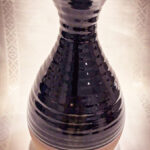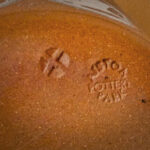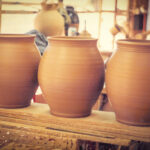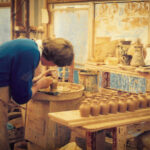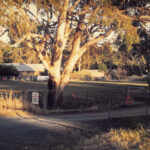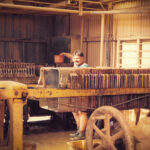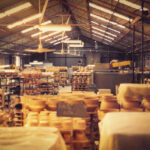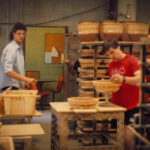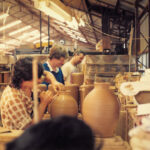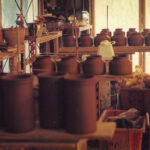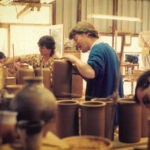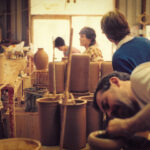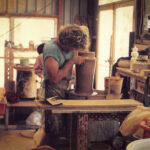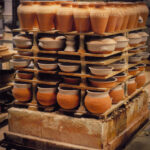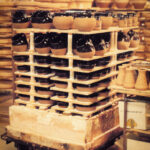I was 20 years of age and working with Joan Campbell when wanderlust got the better of me and I left Joan’s studio to hit the road. By the time I finished working with Joan we had completed several commissions, including the St George Bank fountain commission. I also worked with Joan on her solo exhibition at the Fremantle Arts Centre in late 1989.
I headed off in early 1990 on a surfing odyssey to the Southern states of Australia. After leaving my home in Waterman’s Bay, I headed south following the coast in my trusty Ford panel van with a quiver of surfboards strapped to the roof. I managed to find, and surf, some amazing waves on the Eyre Peninsula, but by the time I arrived in Adelaide in April 1990 money was getting short and I needed to find some work to replenish the kitty if I was to travel further south towards Bells Beach and, ultimately, Tasmania to continue the surfing odyssey.
I found my way to Aiston Park Pottery in an area of Adelaide called Tea Tree Gully. It was at Aiston Park Pottery that I really learnt the skills to become a production potter. I thought that I had good throwing skills after gaining my Advanced Diploma in Studio Ceramics at Perth Technical College and my time working with Joan Campbell, but I soon realised just how much I still needed to learn once I met the production pottery team at Aiston Park.
Aiston Park Pottery was a big pottery manufacturer in South Australia at that time and employed many people to perform the tasks required to prepare clay, throw, operate the jigger and jolly machinery as well as fettle, glaze, load and unload kilns. They sold their ware through the party plan marketing strategy that was used by many pottery manufacturers in the 80’s and 90’s.
I was employed as a member of the Pottery’s throwing team and my task was to make the larger items on the catalogue. The larger ware that I became responsible for was pretty much every item over the 5kg in weight mark. Mostly larger cannisters, bread crocks, flowerpots and wine kegs.
The throwing team consisted of five throwers who were all employed on piece rates. Ultimately, the faster you could throw an item to the correct size with uniformity, the more money per day you could earn. My throwing skills were pretty good when I arrived, but my speed and accuracy had to be improved if I was to make any money as a thrower at Aiston Park.
I took up the challenge and over a period of 12 months I became a true production thrower and part of the team. We were a very competitive bunch always trying to outdo each other at throwing speed or how much money we could earn in a week on the production line. When I arrived, I was the slowest member of the team. I struggled to make $80.00 for a week’s hard work, but I think it would be fair to say that by the time I left I was one of the fastest throwers at Aiston Park. I think my final pay cheque was around $2000, which in 1992 was a lot of money for a week’s work!
It was during my time at Aiston Park that I met John Ferguson, who had worked with Joan Campbell at her Bathers Beach Studio in the late 70’s, and Cathy Franzi, now Dr Cathy Franzi and an internationally acclaimed ceramic artist. Both Cathy and John were employed as throwers at Aiston Park along with David Chapman and Geoff (Sorry Geoff, I can’t remember your surname). David and Geoff were both fantastic production potters. David lived close to where I was staying in Adelaide and would pick me up on his way to work and drop me home again at the end of our working day. David’s parents and brother were potters in Canterbury, England and David had gained a wealth of experience and knowledge from growing up in a family of potters. Geoff lived very close to the pottery and pretty much learnt from an early age how to throw from Mark Heidenreich who had worked at Aiston Park before I arrived. I also visited Bennetts Pottery in Magill and I met all the crew at the Jam Factory.
I left Adelaide with fond memories and a new set of skills. The skills and knowledge I acquired at Aiston Park have been instrumental in creating a strong foundation for my career as a professional potter. Their importance has not diminished over the years and they remain as relevant to my work today as they were when I left Aiston Park more than thirty years ago.

